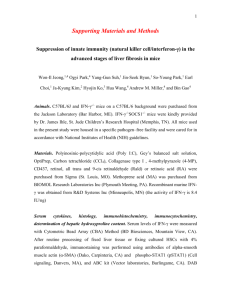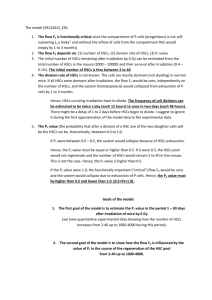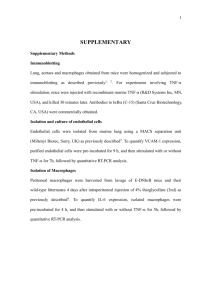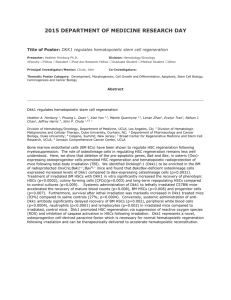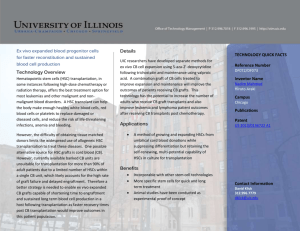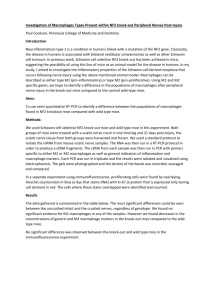hep26429-sup-0012-suppInfo
advertisement
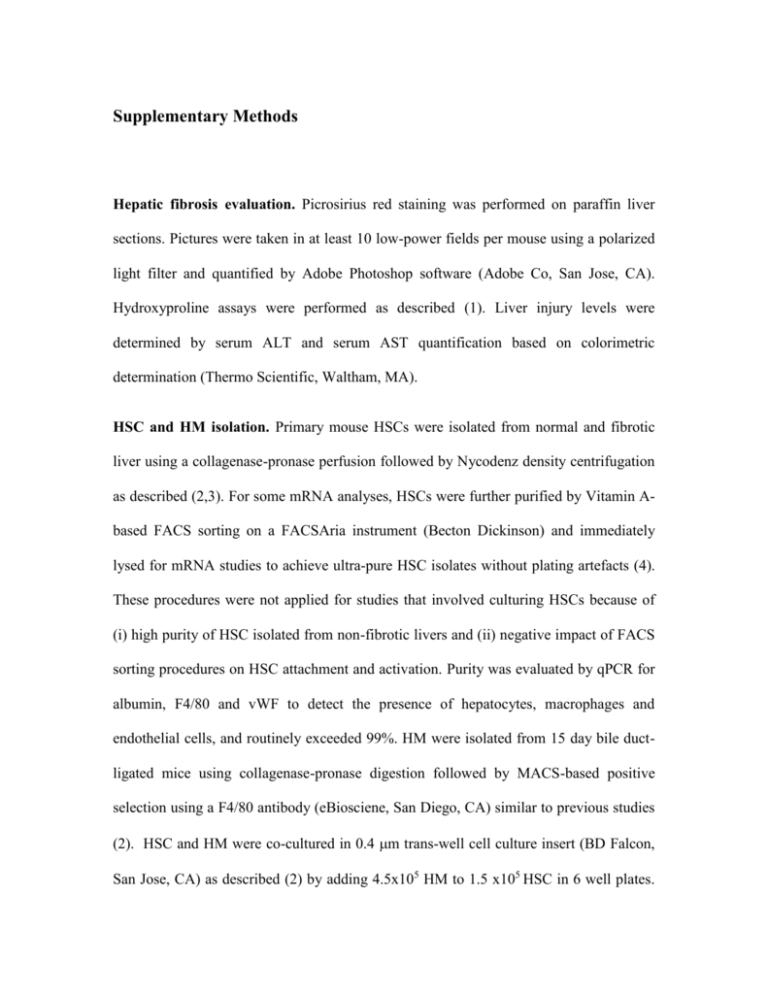
Supplementary Methods Hepatic fibrosis evaluation. Picrosirius red staining was performed on paraffin liver sections. Pictures were taken in at least 10 low-power fields per mouse using a polarized light filter and quantified by Adobe Photoshop software (Adobe Co, San Jose, CA). Hydroxyproline assays were performed as described (1). Liver injury levels were determined by serum ALT and serum AST quantification based on colorimetric determination (Thermo Scientific, Waltham, MA). HSC and HM isolation. Primary mouse HSCs were isolated from normal and fibrotic liver using a collagenase-pronase perfusion followed by Nycodenz density centrifugation as described (2,3). For some mRNA analyses, HSCs were further purified by Vitamin Abased FACS sorting on a FACSAria instrument (Becton Dickinson) and immediately lysed for mRNA studies to achieve ultra-pure HSC isolates without plating artefacts (4). These procedures were not applied for studies that involved culturing HSCs because of (i) high purity of HSC isolated from non-fibrotic livers and (ii) negative impact of FACS sorting procedures on HSC attachment and activation. Purity was evaluated by qPCR for albumin, F4/80 and vWF to detect the presence of hepatocytes, macrophages and endothelial cells, and routinely exceeded 99%. HM were isolated from 15 day bile ductligated mice using collagenase-pronase digestion followed by MACS-based positive selection using a F4/80 antibody (eBiosciene, San Diego, CA) similar to previous studies (2). HSC and HM were co-cultured in 0.4 m trans-well cell culture insert (BD Falcon, San Jose, CA) as described (2) by adding 4.5x105 HM to 1.5 x105 HSC in 6 well plates. HSC and CD11c-positive DC were co-cultured under the same conditions using 3x105 DC and 1x105 HSC. For some experiments, cells were treated with recombinant IL1-β (5 ng/ml), TNFα (30 ng/ml) mouse TNFRSF1A-Fc (0.5 g/ml) and mouse IL-1RI-Fc (0.5 g/ml) chimera (R&D Systems, Minneaopolis, MN) in different combinations. TNFRSF1A-Fc and IL-1RI-Fc containing media was replaced every 48h. For induction of cell death in culture, HSCs were cultured in media containing 0.1% FBS for 4 days. Cell death was visualized by propidium iodide staining, and was quantified by determining the percentage of propidium iodide-positive HSCs. For some experiments, HSCs were infected with either AdIBsr or AdShuttle as described (1). HM characterization. HM profiles were characterized by qPCR using iNos and Cox2 as markers of M1 profile, and Fizz-1 and Ym1 as markers of M2 profile. Thioglycollateelicited peritoneal macrophages treated 16 hours with LPS (10 ng/mL) (Sigma Chemical Co, St Louis, MO) and interferon gamma (10 ng/mL) (PeproTech, Rocky Hill NJ) were used as positive control for the M1 profile. Thioglycollate-elicited peritoneal macrophages treated 16 hours with IL-4 (10 ng/mL) (BioLegend, San Diego CA) and IL10 (10 ng/mL) (PeproTech, Rocky Hill NJ) were used as positive control for the M2 profile. Bone marrow transplantation. C57B6 mice (CD45.1+) were lethally irradiated in two doses of 600 or 660 cGy (every 6 or 12 hours, respectively) and transplanted with 106 whole bone marrow cells from CD11c-DTR-eGfp mice (CD45.2+) for CCl4 experiments (performed at Mount Sinai), and 5x106 whole bone marrow cells from CD11c-DTR-eGfp mice for BDL experiments (performed at Columbia University). The degree of engraftment was checked 12 weeks later and mice with more than 98% engraftment of donor CD45.2+ cells were used for fibrosis induction and cDC depletion. Intrahepatic leukocyte population and DC analysis. The entire intrahepatic leukocyte population was isolated as described previously (5). Multi-parameter analyses of freshly stained cell suspensions were performed on an LSR II (Becton Dickinson) and analyzed with FlowJo software (TreeStar). Intrahepatic leukocyte gating strategy to define pDC and cDC were performed as described. (6). Shortly, after gating on SSC/FSC, exclusion of dead cells and duplets, all cell subpopulations were defined as CD45poslineagenegative (CD3neg, CD19neg, NK1.1/DX5 neg). Gated cells expressing CD11cint, PDCA-1pos were identified as pDC, while cells expressing PDCA-1neg, CD11chigh, MHCIIhigh were identified as cDC. To identify neutrophils and macrophages we excluded DAPIpos dead cells, doublets, CD45neg cells and NK cells. Liver neutrophils were characterized as Ly6GposCD11bpos while in the remaining Ly6G-negative population liver macrophages were identified as CD11bpos F4/80pos. Microarray analysis. Microarray analysis was performed using a combination of previously published data sets (2) for quiescent HSCs (n=5), HSCs from bile-duct ligated mice (n=3) and HSCs from CCl4-treated mice (n=3) in combination with new data sets generated from microarrays using HSCs activated for 5 days in the presence of 10% FBS but the absence of hepatic macrophages (n=3) and HSCs activated for 5 days in the presence of 10% FBS and hepatic macrophages (n=3). All microarray data was generated using the one-cycle cDNA synthesis kit, one-cycle in vitro labeling kit, and mouse genome 430 2.0 array gene chips (all Affymetrix, Santa Clara, CA). Chips were scanned with a Genechip Scanner 3000 7G (Affymetrix). A complete set of quality measures were performed as described (7). Data normalization was done by the GCRMA algorithm. Log fold changes between conditions and the statistical significance of these fold changes were determined using contrasts in Linear Models for MicroArrays LIMMA. Both GCRMA and LIMMA are implemented in Bioconductor/R. All groups were compared with quiescent HSCs (n=5). A Benjamini–Hochberg false-discovery rate < 0.05 was used as the criterion of statistical significance. Clustering was performed with Cluster 3.0 and Java Treeview using the mean of quiescent cells as a reference, the centered correlation distance, and hierarchical clustering. All files have been deposited in the gene expression omnibus (GEO accession number: GSE34640). Overrepresentation of NF-B dependent genes was tested by the 2 method, with positives defined by the Rel/NFkappaB target genes database (8), and the total number of genes being taken to be the total number of unique Entrez Gene identifiers on the Mouse 430.2 chip. Pathway analysis was done by IPA pathways analysis (Ingenuity systems, Redwood City, CA) using all probesets with significant changes (adjusted p-value <0.05) and a least 10-fold up- or downregulation. RNA isolation and qPCR. RNA was isolated from cells and liver tissue by column purification and on column DNAse treatment. After reverse transcription, mRNA levels were determined by quantitative real-time PCR on an Applied Biosystem 7300 PCR cycler, using ABI Taqman primers and probes for Col1a1, Acta2, Timp1, Ch25h, Il6, Cxcl14, Cxcl5, Saa3, Mmp13, Serpinb2, Tnfrsf22 and Tnfrsf23. All qPCRs were quantified using relative standard curves, and normalized to expression of 18s. Immunobloting. Protein extracts from cells or liver tissue were loaded and separated by SDS-PAGE, transferred onto nitrocellulose membranes, and incubated with anti α-SMA (1:1000, Abcam, Cambridge, MA), phosphoS536-p65 (1:1000, Cell Signaling), IκBα (1:1000, Cell Signaling, Danvers, MA) antibodies and reprobed with an antibody against actin (MP Biomedicals, Solon, OH). NF-B reporter assay. NF-B reporter assays were performed as previously described (1). Briefly, HSCs were infected with an adenovirus expressing NF-B-driven luciferase and an adenovirus expressing -galactosidase at a multiplicity of infection of 30. 24h after infection, cells were serum starved in media contain 1% FBS followed by co-culture with hepatic macrophages or empty inserts, or stimulation with TNF (30 ng/ml) or IL1 (5 ng/ml). Immunohistochemistry and immunocytofluorescent staining. Immunohistochemical staining was performed on paraffin liver sections after 10% formalin fixation using primary antibody against desmin (1:200, Lab Vision, Thermo Fisher Scientific, Fremont, CA, USA), F4/80 (Serotech, Raleigh, NC) or against GFP (Abcam, Cambridge, MA), and secondary Alexa Fluor 488. Confocal microscopy was done on a Nikon A1R MP confocal microscope (Nikon Instruments, Melville, NY, USA), with a 40x oil lens. Apoptotic cells were detected using the terminal deoxynucleotide transferase (TdT)mediated dUTP-biotin nick end labeling (TUNEL) method, based on the Apotag Red in Situ apoptosis Detection kit (Millipore, Temecula, CA). For immunocytofluorescence, primary HSCs were fixed with 4% paraformaldehyde and stained using primary antibody against p65 (1:100, Santa Cruz) or cleaved caspase 3 (1:100, Cell Signaling, Danvers, MA) and secondary using Alexa Fluor 594. Counterstaining was done using Alexa Fluor 488 Phalloidin (Molecular Probes). Dead cells were detected using propidium iodide (Sigma Chemical Co, St Louis, MO). Nuclei were stained with Hoechst 33342 (Sigma Chemical Co, St Louis, MO). Supplementary References 1. Seki E, De Minicis S, Osterreicher CH, Kluwe J, Osawa Y, Brenner DA, Schwabe RF. TLR4 enhances TGF-beta signaling and hepatic fibrosis. Nat Med 2007;13:1324-1332. 2. De Minicis S, Seki E, Uchinami H, Kluwe J, Zhang Y, Brenner DA, Schwabe RF. Gene expression profiles during hepatic stellate cell activation in culture and in vivo. Gastroenterology 2007;132:1937-1946. 3. Dapito DH, Mencin A, Gwak GY, Pradere JP, Jang MK, Mederacke I, Caviglia JM, et al. Promotion of hepatocellular carcinoma by the intestinal microbiota and TLR4. Cancer Cell 2012;21:504-516. 4. Troeger JS, Mederacke I, Gwak GY, Dapito DH, Mu X, Hsu CC, Pradere JP, et al. Deactivation of Hepatic Stellate Cells during Liver Fibrosis Resolution in Mice. Gastroenterology 2012;143:1073-1083. 5. Wintermeyer P, Cheng CW, Gehring S, Hoffman BL, Holub M, Brossay L, Gregory SH. Invariant natural killer T cells suppress the neutrophil inflammatory response in a mouse model of cholestatic liver damage. Gastroenterology 2009;136:10481059. 6. Jiao J, Sastre D, Fiel MI, Lee UE, Ghiassi-Nejad Z, Ginhoux F, Vivier E, et al. Dendritic cell regulation of carbon tetrachloride-induced murine liver fibrosis regression. Hepatology 2012;55:244-255. 7. Bolstad BM, Collin F, Brettschneider J, Simpson K, Cope LM, Irizarry R, Speed TP: Quality Assesment of Affymetrix GeneChip Data. In: Gentleman R, Carey V, Huber W, RA I, Dudoit S, eds. Bioinformatics and Computaional Biology Solutions Using R and Bioconductor. New York: Springer, 2005. 8. Gosselin K, Touzet H, Abbadie C. Rel/NF-kappaB target genes. 2004 (http://bioinfo.lifl.fr/NF-KB/). Supplementary Figure legends Supplementary Figure 1: Purity of F4/80-positive hepatic macrophages. A-B. Purity of MACS-sorted F4/80-positive hepatic macrophages was determined by FACS analysis for F4/80 (A) and by phagocytosis of fluorogenic pHrodo Bioparticles that selectively emit fluorescence after phagocytosis (B). C. M1 and M2 profiles in HM from sham and BDL livers were assessed by qPCR for M1 markers iNos and Cox2, and M2 markers Fizz-1 and Ym1 (left panel). Thioglycollate-elicited peritoneal macrophages treated 16 hours with LPS (10 ng/mL) and interferon gamma (10 ng/mL) were used as positive control for the M1 profile (right panel). Thioglycollate-elicited peritoneal macrophages treated 16 hours with IL-4 (10 ng/mL) and IL-10 (10 ng/mL) were used as positive control for M2 profile (right panel). Supplementary Figure 2. IPA pathway analysis from microarrays HSCs co-cultured with hepatic macrophages. A. Displayed are the 20 most significant categories of IPA tox functions. B. Displayed are the 20 most significant categories of IPA biological functions. Supplementary Figure 3. Inhibition of NF-B-dependent gene expression by IKK inhibitor BAY 11-7082. A-B. mRNA expression of HSC activation markers or NF-B responsive genes was determined after treatment with rmIL-1 (5 ng/ml) for 3h (A) and 24 hours (B) in the presence or absence of BAY 11-70-82 (1 M). C-D. mRNA expression of HSC activation markers or NF-B responsive genes was determined by qPCR in HSC cultured with HM supernatant in the presence or absence of BAY 11-7082 (1M) for 4h (C) and 24h (D). Supplementary Figure 4. Macrophage depletion reduces CCl4- and BDL-induced liver fibrosis. A-D. Mice underwent BDL for 15 days and were injected with vehicle or clodronate as depicted (A). Hepatic fibrosis was determined by Picrosirius red staining and morphometric analysis using polarized light for vehicle-treated (n=14) and clodronate- treated (n=10) mice (B), and by hepatic expression of fibrogenic genes using qPCR (C). Depletion of F4/80-positive liver macrophages was confirmed by F4/80 immunohistochemistry (D). E-H. Mice received clodronate or vehicle injections during CCl4-induced hepatic fibrosis as depicted (E) with the CCL4 dose for day 1 and 5 being 0.125μl/g and 0.25μl/g for the remaining injections. Hepatic fibrosis in vehicle-treated (n=10) and clodronate-treated (n=8) mice was determined by Picrosirius red staining and morphometric analysis using polarized light (F) and by hepatic expression of fibrogenic genes using qPCR (G). Depletion of F4/80-positive liver macrophages was confirmed by F4/80 immunohistochemistry (H). I. Bile duct ligated mice were injected every 5 days for a total of 3 injections with PBS (n=4) or clodronate (n=3) followed by quantification of F4/80- CD11b- double positive macrophages using flow cytometry FACS plots show percentage of double positive cells, the bar graph shows cell numbers per gram liver. *p<0.05 ** p<0.01 Supplementary Figure 5. IL-1 and TNF do not contribute to HSC activation HSCs were serum starved in 0.1% FBS in the presence or absence of hepatic macrophages, and the absence or presence of rmIL-1 (5 ng/ml). Cell death was determined by propidium iodide staining (red). Nuclei were visualized by Hoechst staining (blue). *p<0.05; **p<0.01. Supplementary Figure 6. IL-1 receptor deficient mice do not display reduced liver fibrosis in multiple fibrosis models. A-D. Wild-type and IL-1R-deficient mice were subjected to fibrosis induction by bile duct ligation for 3 weeks (A, n=11 wild-type mice and n=7 IL-1R knockout mice), treatment with 8 injections of CCl4 (B, n=10 mice/group), treatment with 20 injections of CCl4 (C, n=8 mice/group), or 18 weeks of thioacetamide in drinking water (D, 15 wild-type mice and 12 IL-1Rko mice). Hepatic fibrosis was quantified by Sirius Red staining and morphometry. Supplementary Figure 7. Hepatic macrophages upregulate Trail decoy receptor expression in hepatic stellate cells. A. mRNA expression of Trail decoy receptors Tnfrsf22 and Tnfrsf23 was determined qPCR in HSC co-cultured with HM in the presence or absence of an antagonistic TNFRI-Fc chimera, an antagonistic IL-1RI-Fc chimera or both. B. Expression of Trail decoy receptors Tnfrsf22 and Tnfrsf23 was determined by qPCR in ultrapure unplated HSCs isolated from 15 day bile duct-ligated vehicle-treated mice (n=6 isolations) and clodronate-treated mice (n=4 isolations) by a combination of gradient centrifugation and FACS analysis without additional plating. Data is expressed as fold induction in comparison to quiescent HSCs isolated from control wt mice (n=3 isolations), or as ratio between the investigated mRNA and 18s mRNA if mRNA expression was not detectable in qHSC. *p<0.05; **p<0.01. Supplementary Figure 8. Depletion of dendritic cells by CD11c-DTR and 120-G8 antibody-mediated ablation. A. Livers of PBS- and DT-treated chimeric CD11c-DTReGFP mice after 4 weeks of fibrosis induction was harvested, and freshly isolated intrahepatic leukocytes where flox-cytometerically analyzed for frequency of cDC. B. Liver of C57Bl/6 mice after 4 weeks of CCL4 fibrogenesis, with or without 120G8 antibody treatment, were analyzed flow-cytometrically for the frequency pDC. C. Spleens from PBS- and DT-treated CD11c-DTR-eGFP chimeric mice were harvested 24h after the last injection. Splenocytes were isolated and CD11c-driven eGFP expression was determined by flow cytometry. Supplementary Figure 9. Neutrophilia in mice with dendritic cell ablation by CD11c-DTR. CD11c-DTR chimeric mice received DT treatment as described in the Methods. 24 hours after the last DT injection, livers were collected and hepatic neutrophil numbers was determined by flow cytometry using Ly6G and CD11b. FACS plots show percentage of double positive cells, the bar graph shows cell numbers per gram liver. *p<0.05, * p<0.01 Supplementary Table 1. Genes with more than 2-fold and significant up- or downregulation induced by co-culture of HSCs with hepatic macrophages. Shown are all probe sets with more than 2-fold up- or downregulation after co-culture with hepatic macrophages for 5 days. Displayed are the fold induction, p-value and adjusted pvalue. In addition, comparison of activated HSCs, activated HSCs co-cultured with hepatic macrophages, bile duct ligation activated HSCs and CCl4-activated HSCs with quiescent HSCs are included for each probe set. Supplementary Table 2. List of NF-B genes with more than 10-fold upregulation in HSCs after co-culture with hepatic macrophages. Shown is a list of genes with more than 10-fold induction in HSCs after co-culture with hepatic macrophages for 5 days. Genes that are NF-B dependent are annotated with the relevant data source. Shown is the fold induction.
